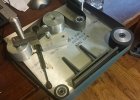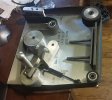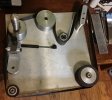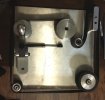- Joined
- Jan 10, 2015
- Messages
- 1,673
Brock, nobody had responded to your question about 1800 vs 3600 rpm motor. If price where the same, I'd go with 1800 rpm for the horizontal grinder. From your discussion it seems you're not planning to hog with the grinder, but use it same as I will, low rpm and low torque requirements, hence the 1hp motor. With a 4" drive wheel and 1800 you'll be running around 2,000 sfpm belt speed which should be just fine. I went with 1-1/2 hp - don't think I'll need that much power, and on reflection maybe I should have went with 1800 rpm 1hp motor. The cost of a 1 hp, 1800 rpm motor is only $11 more than the 3600 rpm 1-1/2 hp motor so I did get the 1-1/2 hp motor.
Not considering the price, I'd go with 1800 rpm.
Thanks Ken for the confirmation. That is what I am going to do. Ordering tomorrow.







